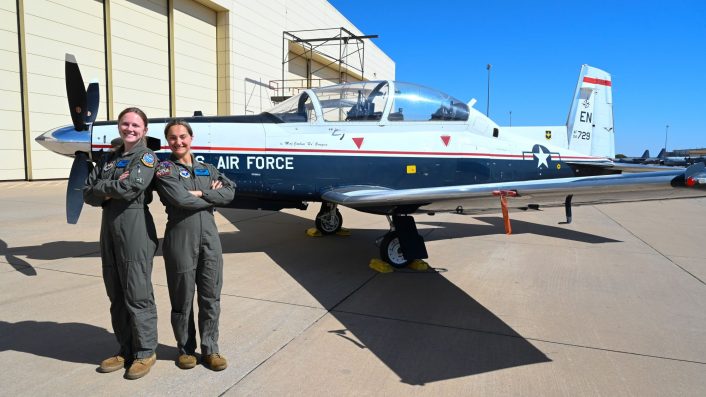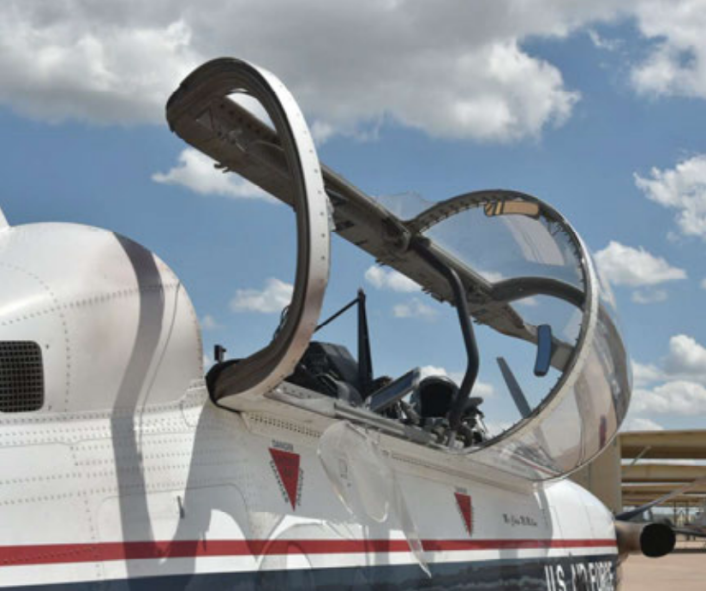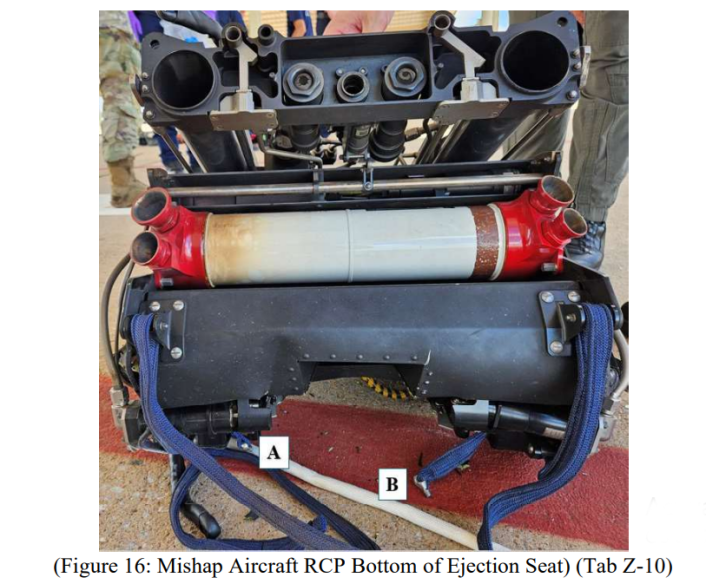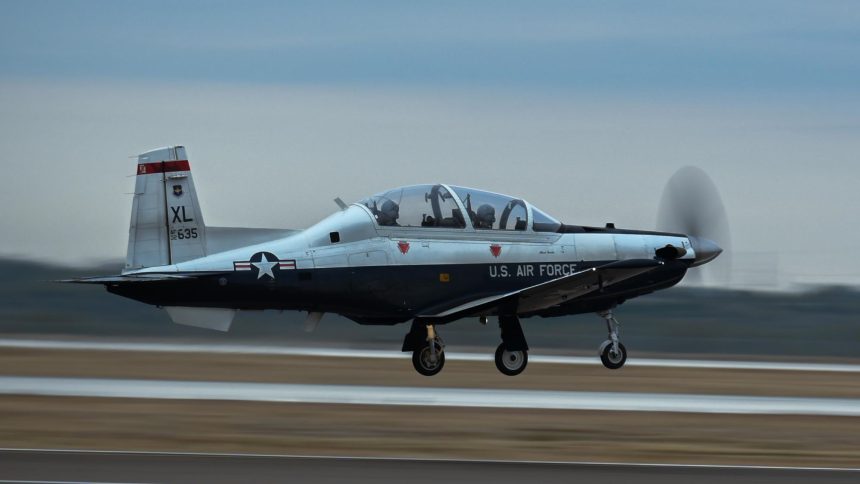The AAIB found the seat’s safety pin was not fully installed and the previously disconnected harness chest strap caught on and inadvertently actuated the seat’s handle.
An improperly inserted safety pin after landing and a disconnected harness chess strap getting caught on the ejection seat handle caused the accidental ejection that killed T-6A Texan II instructor pilot on May 13, 2024 at Sheppard AFB, Texas. An Accident Investigation Board (AAIB) report released on Jun. 23, 2025, also observed that unbuckling while still taxiing after landing was found to be a common practice by some T-6A instructors, although proper guidelines about when to disconnect from the seat are not provided.
The deceased instructor pilot, Capt. John Robertson, and the student pilot, were assigned to the 80th Operations Support Squadron, and flew with the 89th Flying Training Squadron within the 80th Flying Training Wing. Robertson was ejected nearly 100 feet into the air and, since he was not connected to the parachute, crashed down through the roof of an aircraft sunshade.
Robertson passed away in the hospital the following day due to “non-survivable injuries,” said a summary of the AAIB report. The student pilot did not eject and thus did not sustain injuries, safely stopping the aircraft and shutting it down.
The AAIB report noted Robertson’s “respected” status among the leadership, fellow instructors, and students, adding that he was also recognized as the Instructor Pilot of the Year for 2023. He would also “spend extra time” on difficult topics with struggling students to help them succeed.
The 80th Flying Training Wing, under the Air Education and Training Command (AETC), is part of the Euro-NATO Joint Jet Pilot Training (ENJJPT) program, the world’s only internationally manned and managed flying training program which is meant to train combat pilots for NATO. It includes participants from 14 NATO member countries, including the United States, Germany, Italy and Turkey.
The T-6A is a single-engine, two-seat primary trainer aircraft used to teach basic flying skills to students in the Joint Primary Pilot Training (JPPT) program for both the U.S. Air Force and Navy. The T-6A was officially named the Texan II in 1997 when it entered service. The aircraft is equipped with Martin-Baker US16LA ejection seats.

Safety pin
AAIB investigators relied on physical examination of the spot, the aircraft, evidence recovered from the scene and several trials on simulators to reach their findings. The mishap flight was Robertson’s second sortie that day, while he was scheduled for only one instruction flight on the T-6A.
This is what the summary of the AAIB report said:
“The mishap was caused by the instructor pilot failing to fully install the ejection seat safety pin during the after landing checklist. Additionally, during taxi, the instructor pilot partially disconnected from the rear cockpit ejection seat system, including the parachute. During that process of disconnecting from various connection points to the ejection seat, the instructor pilot’s harness chest strap V-ring unknowingly got caught on and inadvertently activated the ejection seat control handle, initiating the ejection sequence.”

The said Texan II, tail 08-3915, landed on Sheppard AFB’s Runway 33R with the Mishap Instructor Pilot (MIP) Robertson in the rear seat and the Mishap Student Pilot (MSP), who was piloting the aircraft, in the front. During taxi, upon clearing the runway, the MSP initiated the standard After Landing Checklist, “including verbal question-and-answer steps, with the MIP.”
This stage includes inserting the safety pin into their ejection seats, when Robertson did not fully install it in his own seat. An experienced instructor interviewed by the AAIB mentioned “he observed student pilots improperly install the safety pin halfway on several occasions.”
The board drew the conclusion about the improperly installed pin based on the “elongation of the seat safety pin hole on both the leading surface of the housing and the front edge of the ejection handle.” The report further adds “the elongation is only possible if the pin was installed”, which “indicates the seat safety pin was at least partially installed during the ejection sequence.”
Ejection seat handle actuation
Following the partial disconnection from the seat, Robertson “inadvertently actuated” the ejection handle and was thrown from the aircraft, while remaining “partially connected to, and seated in, the ejection seat until automatic seat/pilot separation.” At this point the pilot and seat are meant to separate, followed by the parachute being deployed. However, since Robertson had disconnected from his parachute, there was nothing to arrest his descent.

To determine the cause behind the inadvertent activation of the ejection seat control handle, AAIB investigators analyzed multiple scenarios, including using the T-6A simulator to “recreate chest strap positioning scenarios in the T-6A cockpit.” That recreation showed that disconnecting the harness chest strap caused both the ejector snap and the V-ring “to hang from the pilot’s harness.”
While reaching down to disconnect the left leg restraint garter, the V-ring from the pilot’s harness chest strap “can unknowingly become caught in the ejection seat control handle.” Thus, while sitting back upright “the pilot can inadvertently actuate the ejection seat control handle if the V-ring from the pilot’s harness chest strap is caught in the ejection seat control handle and the seat safety pin is not fully installed into the seat,” the report states.
Notably, the report noted that unbuckling and disconnecting from the “ejection seat connections while still taxiing, before the plane comes to a complete halt, is a common practice not only with Robertson, who had done the same in his first instruction flight that morning, but also among other instructors. “The After Landing Checklist, Engine Shutdown Checklist, and Before Leaving Aircraft Checklist in the T-6A Flight Manual do not include information on when to disconnect from the ejection seat,” says the AAIB.










